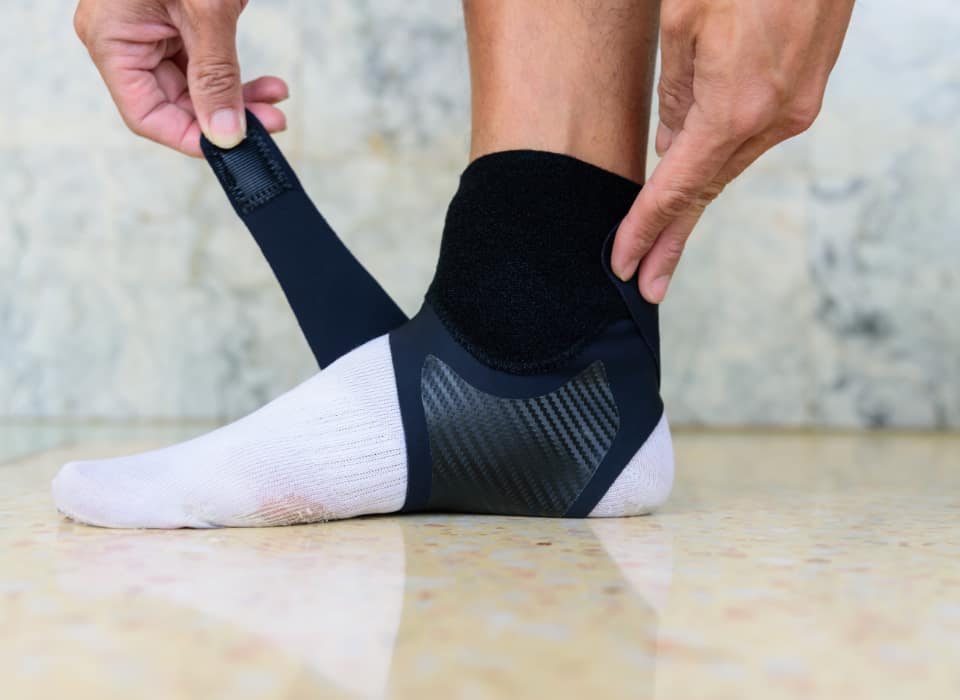Chronic ankle pain Perth
Why would you need an ankle fusion?
Severe ankle arthritis can cause a lot of pain and impact your overall mobility significantly. If this sounds like your case, you may already have tried first-line treatments such as physical therapy, medications, wearing braces, or even pain injections, without long-lasting success.
If you still have chronic pain, you may consider surgery, and ankle fusion is one of your options for severe ankle arthritis.

The most common reasons for ankle fusion surgery are osteoarthritis, rheumatoid arthritis and post-traumatic arthritis. Certain severe fractures or deformities may also be a reason to have ankle fusion surgery.
Is ankle fusion surgery the best option for me?
Ankle fusion surgery is not for everyone. At The Foot & Ankle Centre in Perth we will perform a clinical assessment to determine which surgical option is best for you.
When severe pain and reduced mobility impact your quality of life, and first-line treatments do not work for you, you might be a candidate. However, if you rely heavily on ankle mobility for specific activities this may not be the best option for you. Also people with infections, poor blood supply to the foot or severe osteoporosis may not be suitable candidates.
Ankle fusion surgery Perth
How is ankle fusion performed?
The aim of ankle fusion surgery is to join the shinbone to the ankle bone so they grow together into one solid unit. This fusion will have an immediate effect as it stops the motion in the painful joint. As a result, your pain will stop and your quality of life improves.
Ankle fusion surgery typically involves:
- Removing the damaged joint surfaces
- Aligning the bones in the correct position
- Using screws, plates or rods to secure the bones together
- A bone graft will be required
Once you have recovered after surgery, the fused ankle will be stable but it will be hard to point your toes downward (like going down stairs) or lifting your toes upwards towards your shin (for example when walking uphill).
As you can see, this type of surgery is great to alleviate your pain but it does have its limitations when it comes to up-and-down movements. We will discuss all of this during consultation, so you know exactly what to expect of this type of ankle surgery.

Ankle fusion Perth
Ankle fusion surgery in more detail
Ankle fusion surgery is performed under general anaesthesia. Depending on the individual case, a short hospital stay of a few nights may be necessary.
The surgery focuses on promoting bone growth between the shin bone (tibia) and ankle bone (talus), making sure they fuse together over time. Metal implants such as screws, plates or sometimes rods are used to stabilise and hold the bones together while they heal and fuse. Over time, the bones grow together and become a single, stable unit.
The metal implants provide the necessary stability during this healing process. In rare cases, the implants are removed, but most of the time they remain in place for the rest of your life.

Ankle fusion surgery typically takes around two to three hours to complete.
Ankle fusion recovery
| Big operation: | It's considered a major surgery but ankle fusion is routine for experienced orthopaedic surgeons. |
| Nights in hospital: | Most patients stay 1-2 nights, but this can vary depending on individual recovery. |
| Swelling: | Some swelling is expected post-surgery. Elevation and icing is recommended. |
| Walking boot: | You may need to wear a walking boot for several weeks to keep the ankle stable. |
| Crutches: | Patients typically require crutches for 6-8 weeks, but this can vary depending on each individual’s case. |
| Physio: | You'll need physiotherapy to regain strength and optimise foot function. |
What are potential complications?
While rare, complications can include.
General surgical risks include:
- Anaesthetic difficulties
- Blood loss
- Blood clots
- Infections
- Surgical injury to nerves and other structures.
- Death is very rare but people with serious medical conditions can have deterioration during surgery.
Fusion-related risks:
- Non-union where bones don’t fuse.
- Malunion or incorrect bone fusion.
- Pain in adjacent joints due to altered foot mechanics.
Ankle fusion surgeon Perth
Why The Foot & Ankle Centre?
From treating high-performing athletes to everyday people suffering chronic pain, we understand what you are going through and we are passionate to help you achieve a full and active life.

You are welcome to make an appointment at The Foot & Ankle Centre. We try to see patients as quickly as possible.



